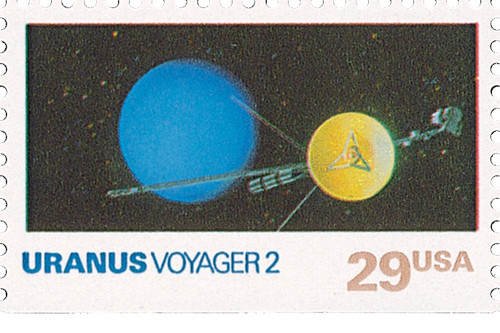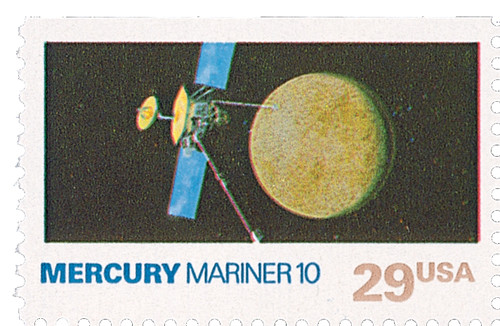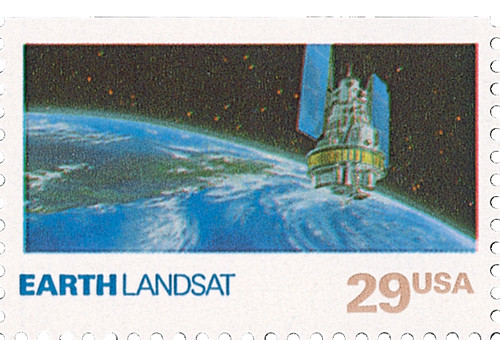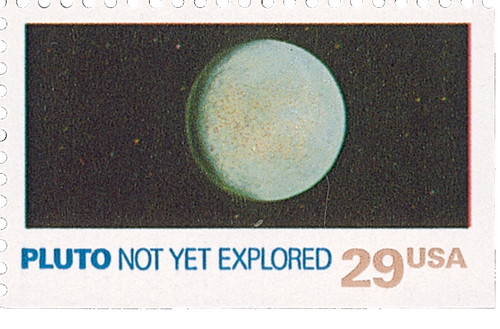
# 2575 - 1991 29c Space Exploration: Uranus
US #2574
1991 Uranus
- Part of set picturing nine planets and Earth’s moon
- Issued as part of Stamp Collecting Month
Category of Stamp: Commemorative
Set: Space Exploration
Value: 29¢
First Day of Issue: October 1, 1991
First Day City: Pasadena, California
Quantity Issued: 33,394,800
Printed by: Bureau of Engraving and Printing
Printing Method: Photogravure
Format: Booklets – 2 panes of 10 in each
Perforations: 11
Reason the stamp was issued: The set of Space Exploration stamps was issued in honor of the Voyager 2 space probe passing Neptune and the 11th annual Stamp Collecting Month.
About the stamp design: The Uranus stamp pictures the planet and the Voyager 2 space probe. The probe was launched in August 1977 to study the outer planets. It visited Jupiter, Saturn, Uranus, and Neptune.
These stamps were the first by Ron Miller, a former artist for the Smithsonian Institution’s National Air and Space Museum. He was asked to picture each of the Sun’s nine planets and the Earth’s moon with a spacecraft. This was to tie in the idea of America’s exploration of space. His original acrylic paintings were larger than those normally used for stamp art. This was to show all the details of the spacecraft.
Special design details: While most of the stamps name the spacecraft shown, the Pluto stamp has “not yet explored,” because no spacecraft had reached that planet at the time. (The space probe New Horizons explored Pluto in 2015.)
First Day City: The First Day of Issue ceremony took place at the Jet Propulsion Laboratory in Pasadena, California, on October 1, 1991, the start of Stamp Collecting Month.
Unusual thing about this stamp: The USPS partnered with Paramount Studios to promote the stamps. The studio was celebrating the 25th anniversary of the Star Trek movies and television series. The stamp designs were unveiled on the bridge of the Starship Enterprise, the space vehicle featured in the series. Flyers promoting the stamps were included in the packaging of Star Trek video cassettes.
About National Stamp Collecting Month stamps: October has been designated by the US Postal Service as National Stamp Collecting Month. The first celebration occurred in 1981 as a way to promote the hobby of collecting stamps. Each year, new stamps are issued in early October to stimulate additional interest, and many philatelic organizations hold special programs during the month. The theme for the 1991 celebration was “Journey to a New Frontier… Collect Stamps.”
History the Space Exploration stamps represent: Uncovering the mysteries of the universe has been a pursuit of scientists and dreamers for all time. With the invention of telescopes, astronomers discovered some of the wonders of space. With the space age, researchers began sending spacecraft outside of Earth’s orbit to gain further insight into the planets of our solar system. Manned missions were followed by unmanned missions with the capability of traveling to distant planets. These stamps show some of the spacecraft and the images of the planets they captured as they flew by. Discoveries continue to be made with the space probes that still travel through our solar system.
History this stamp represents:
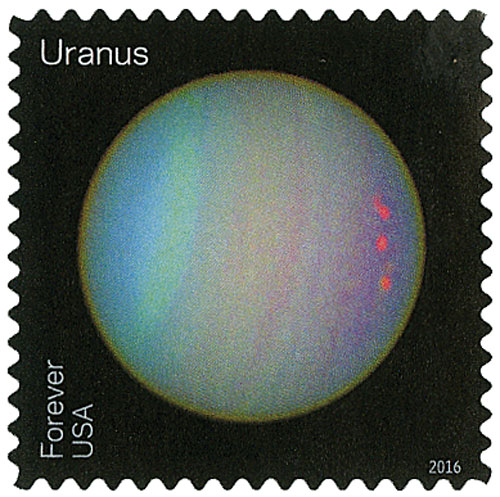
On March 13, 1781, William Hershel discovered Uranus, the first of the planets to be discovered in modern times.
Prior to Hershel's discovery, all of the known planets were identified thousands of years prior. In fact, other stargazers had seen the planet as early as 128 BCE, but believed it was a star.
Herschel, the first to discover a planet using a telescope, initially believed what he saw was a comet, and not a planet. He first observed Uranus on March 13, 1781, at his home in Somerset, England. Using a telescope of his own design, he then conducted a series of observations of the stars to track it.
When he presented his findings to the Royal Society, Herschel concluded that it was a comet, while still comparing it to a planet. When he informed another astronomer of his discovery, he received the confused reply, "I don't know what to call it. It is as likely to be a regular planet moving in an orbit nearly circular to the sun as a Comet moving in a very eccentric ellipsis. I have not yet seen any coma or tail to it."
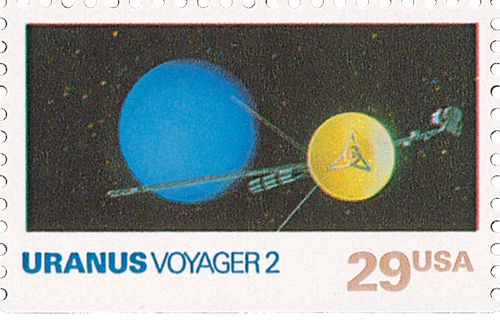
Though Herschel was still convinced he'd found a comet, others believed it was a planet. Anders John Lexell studied its orbit and found it to be almost entirely circular, which convinced him it was a planet and not a comet. About two years after his discovery, Herschel admitted that it must be a planet, it was generally accepted as such. For his role in the planet's discovery, Hershel received an annual stipend and moved to Windsor so the Royal Family could use his telescopes.
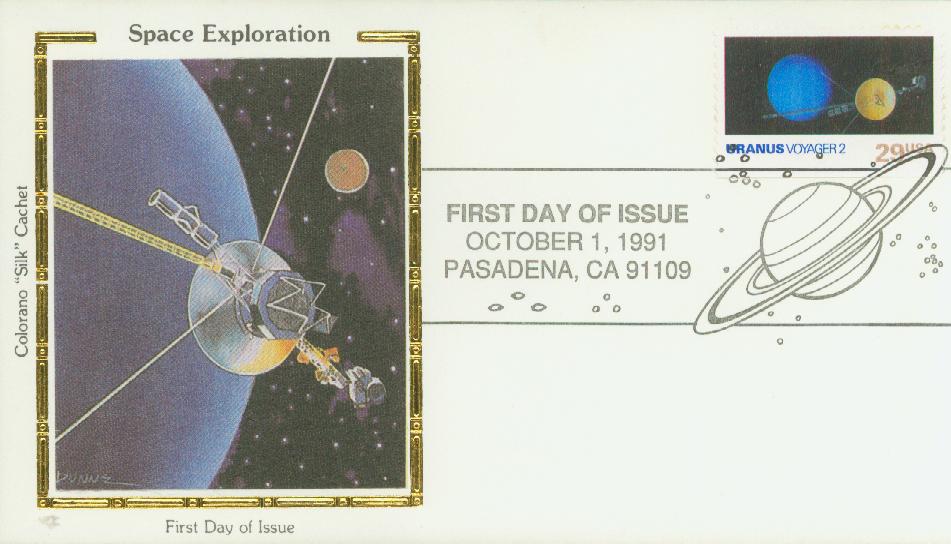
However, naming the new planet would be the matter of debate for nearly 70 years. As its discoverer, Herschel was given the honor of naming the new planet. He wanted to name it Georgium Sidus (George's Star), or the "Georgian Planet" after King George III. He believed all the other planets had been named after gods because they were those cultures' heroes. So he reasoned that, "if in any future age it should be asked, when this last-found Planet was discovered? It would be a very satisfactory answer to say, 'In the reign of King George the Third.'"
However, most people outside of Britain didn't like Herschel's idea. One astronomer suggested it be named for Herschel, while another suggested Neptune. German astronomer Johann Bode proposed Uranus, the Latin name for the Greek god of the sky Ouranos. Bode believed that the name should be based in mythology as all the others were, so it wouldn't stand out. It also seemed fitting since Saturn was the father of Jupiter, so the new planet should be named after the father of Saturn.
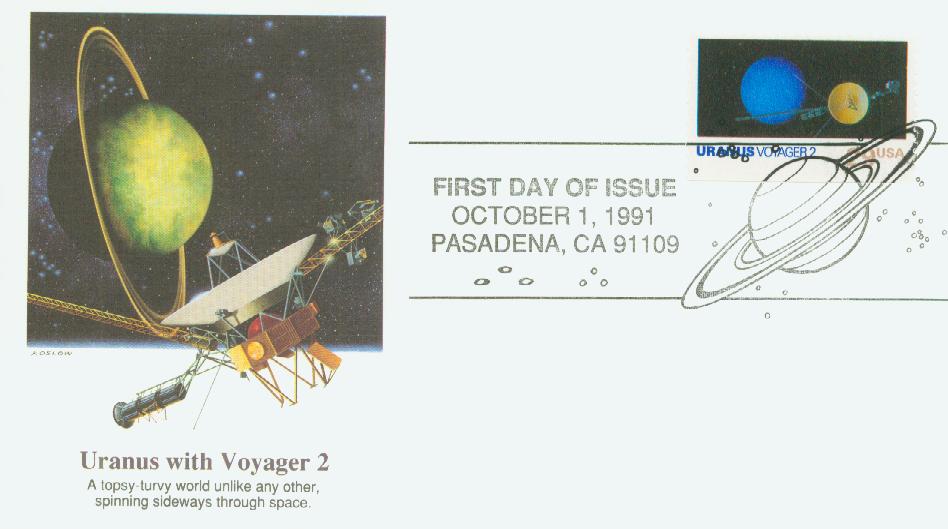
The name Uranus caught on and received widespread support. The newly discovered element uranium was named to show support for Bode's idea. By 1850, Uranus was officially adopted as the name for the seventh planet.
Click here for more on Uranus from the NASA website.
US #2574
1991 Uranus
- Part of set picturing nine planets and Earth’s moon
- Issued as part of Stamp Collecting Month
Category of Stamp: Commemorative
Set: Space Exploration
Value: 29¢
First Day of Issue: October 1, 1991
First Day City: Pasadena, California
Quantity Issued: 33,394,800
Printed by: Bureau of Engraving and Printing
Printing Method: Photogravure
Format: Booklets – 2 panes of 10 in each
Perforations: 11
Reason the stamp was issued: The set of Space Exploration stamps was issued in honor of the Voyager 2 space probe passing Neptune and the 11th annual Stamp Collecting Month.
About the stamp design: The Uranus stamp pictures the planet and the Voyager 2 space probe. The probe was launched in August 1977 to study the outer planets. It visited Jupiter, Saturn, Uranus, and Neptune.
These stamps were the first by Ron Miller, a former artist for the Smithsonian Institution’s National Air and Space Museum. He was asked to picture each of the Sun’s nine planets and the Earth’s moon with a spacecraft. This was to tie in the idea of America’s exploration of space. His original acrylic paintings were larger than those normally used for stamp art. This was to show all the details of the spacecraft.
Special design details: While most of the stamps name the spacecraft shown, the Pluto stamp has “not yet explored,” because no spacecraft had reached that planet at the time. (The space probe New Horizons explored Pluto in 2015.)
First Day City: The First Day of Issue ceremony took place at the Jet Propulsion Laboratory in Pasadena, California, on October 1, 1991, the start of Stamp Collecting Month.
Unusual thing about this stamp: The USPS partnered with Paramount Studios to promote the stamps. The studio was celebrating the 25th anniversary of the Star Trek movies and television series. The stamp designs were unveiled on the bridge of the Starship Enterprise, the space vehicle featured in the series. Flyers promoting the stamps were included in the packaging of Star Trek video cassettes.
About National Stamp Collecting Month stamps: October has been designated by the US Postal Service as National Stamp Collecting Month. The first celebration occurred in 1981 as a way to promote the hobby of collecting stamps. Each year, new stamps are issued in early October to stimulate additional interest, and many philatelic organizations hold special programs during the month. The theme for the 1991 celebration was “Journey to a New Frontier… Collect Stamps.”
History the Space Exploration stamps represent: Uncovering the mysteries of the universe has been a pursuit of scientists and dreamers for all time. With the invention of telescopes, astronomers discovered some of the wonders of space. With the space age, researchers began sending spacecraft outside of Earth’s orbit to gain further insight into the planets of our solar system. Manned missions were followed by unmanned missions with the capability of traveling to distant planets. These stamps show some of the spacecraft and the images of the planets they captured as they flew by. Discoveries continue to be made with the space probes that still travel through our solar system.
History this stamp represents:

On March 13, 1781, William Hershel discovered Uranus, the first of the planets to be discovered in modern times.
Prior to Hershel's discovery, all of the known planets were identified thousands of years prior. In fact, other stargazers had seen the planet as early as 128 BCE, but believed it was a star.
Herschel, the first to discover a planet using a telescope, initially believed what he saw was a comet, and not a planet. He first observed Uranus on March 13, 1781, at his home in Somerset, England. Using a telescope of his own design, he then conducted a series of observations of the stars to track it.
When he presented his findings to the Royal Society, Herschel concluded that it was a comet, while still comparing it to a planet. When he informed another astronomer of his discovery, he received the confused reply, "I don't know what to call it. It is as likely to be a regular planet moving in an orbit nearly circular to the sun as a Comet moving in a very eccentric ellipsis. I have not yet seen any coma or tail to it."

Though Herschel was still convinced he'd found a comet, others believed it was a planet. Anders John Lexell studied its orbit and found it to be almost entirely circular, which convinced him it was a planet and not a comet. About two years after his discovery, Herschel admitted that it must be a planet, it was generally accepted as such. For his role in the planet's discovery, Hershel received an annual stipend and moved to Windsor so the Royal Family could use his telescopes.

However, naming the new planet would be the matter of debate for nearly 70 years. As its discoverer, Herschel was given the honor of naming the new planet. He wanted to name it Georgium Sidus (George's Star), or the "Georgian Planet" after King George III. He believed all the other planets had been named after gods because they were those cultures' heroes. So he reasoned that, "if in any future age it should be asked, when this last-found Planet was discovered? It would be a very satisfactory answer to say, 'In the reign of King George the Third.'"
However, most people outside of Britain didn't like Herschel's idea. One astronomer suggested it be named for Herschel, while another suggested Neptune. German astronomer Johann Bode proposed Uranus, the Latin name for the Greek god of the sky Ouranos. Bode believed that the name should be based in mythology as all the others were, so it wouldn't stand out. It also seemed fitting since Saturn was the father of Jupiter, so the new planet should be named after the father of Saturn.

The name Uranus caught on and received widespread support. The newly discovered element uranium was named to show support for Bode's idea. By 1850, Uranus was officially adopted as the name for the seventh planet.
Click here for more on Uranus from the NASA website.

